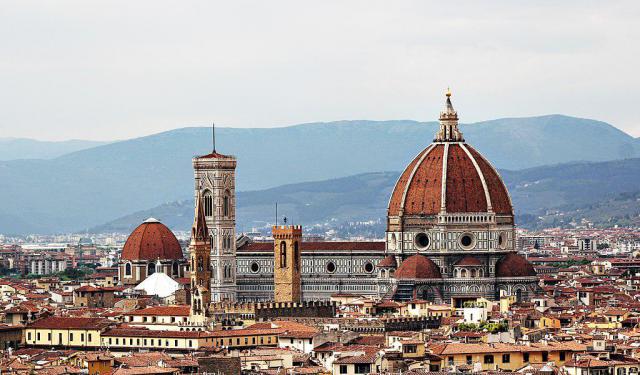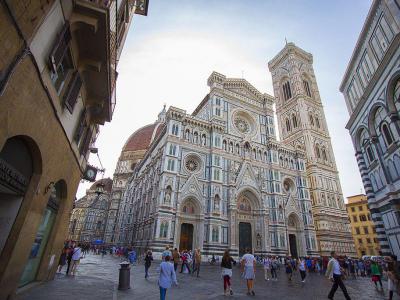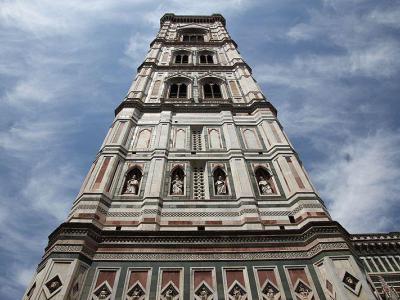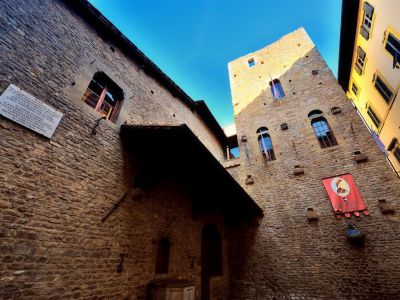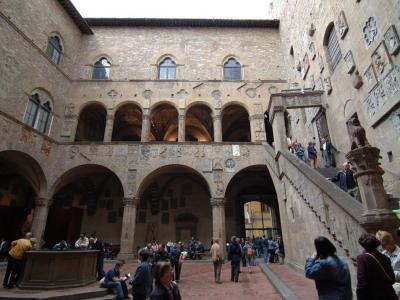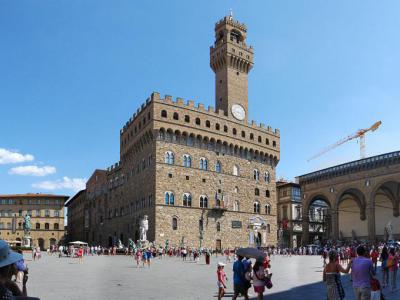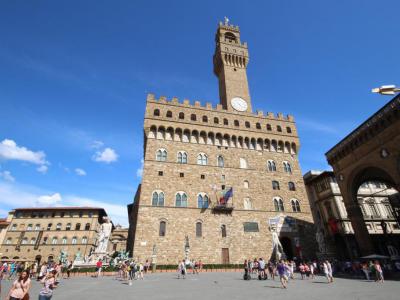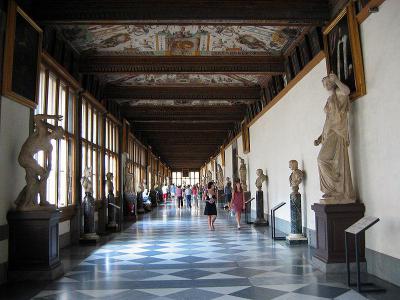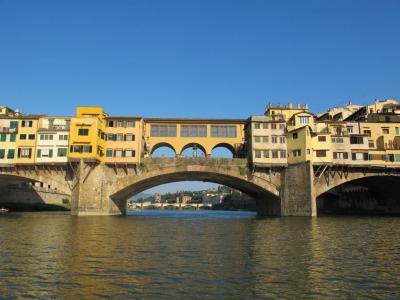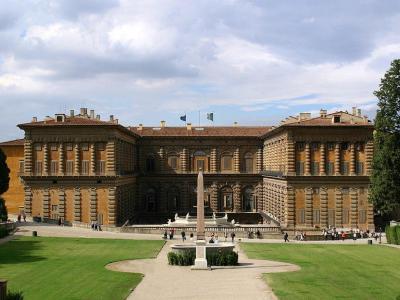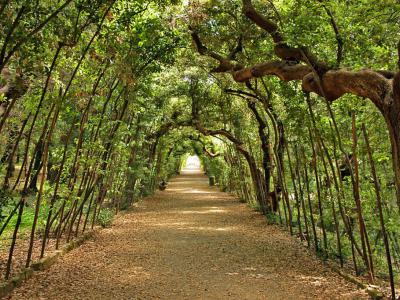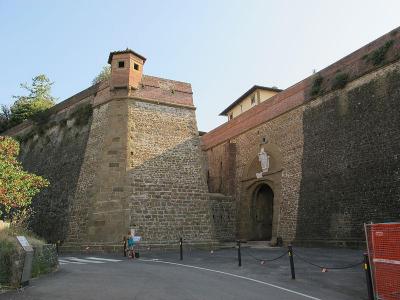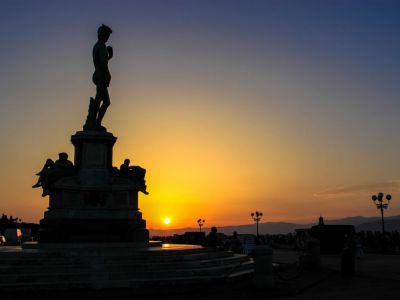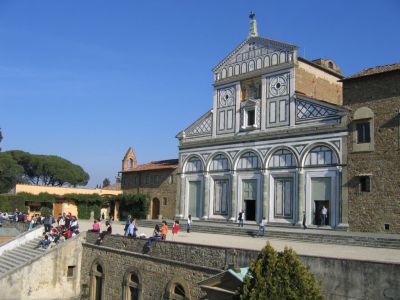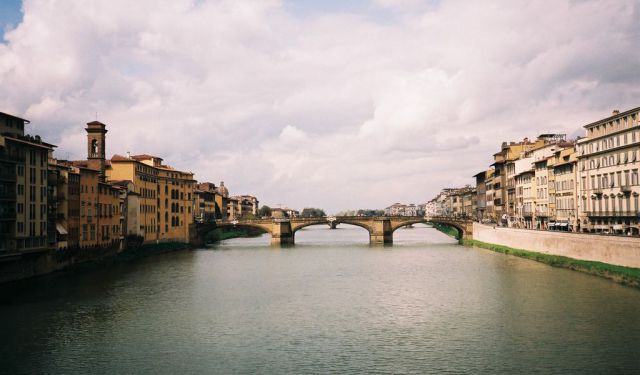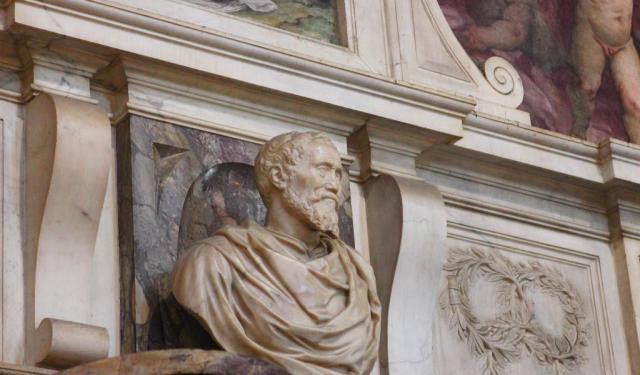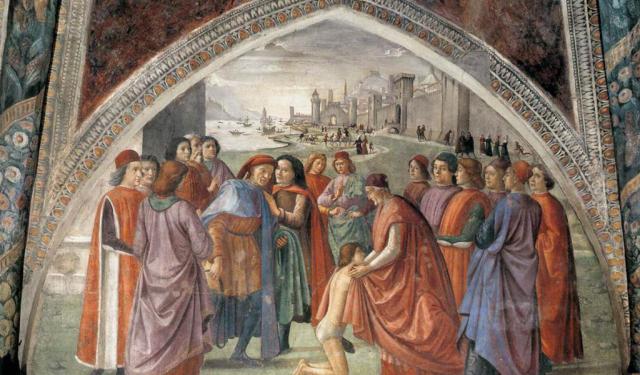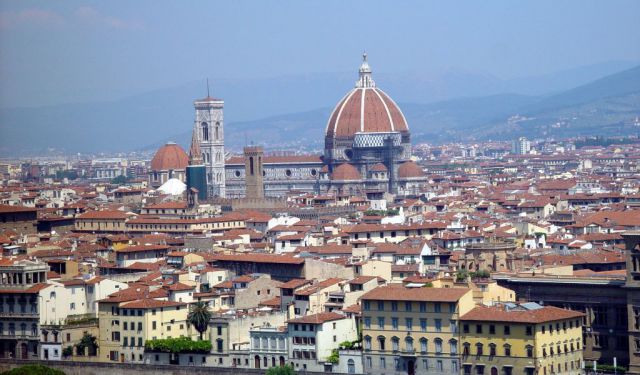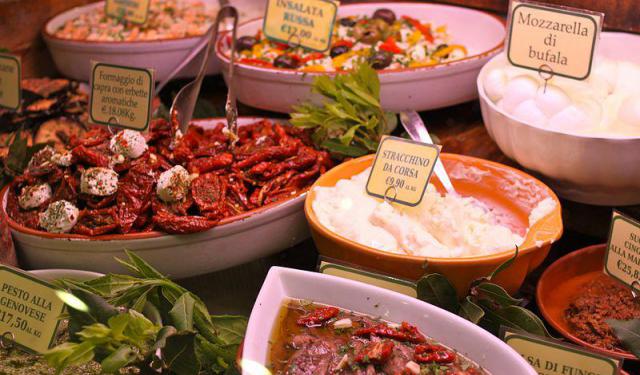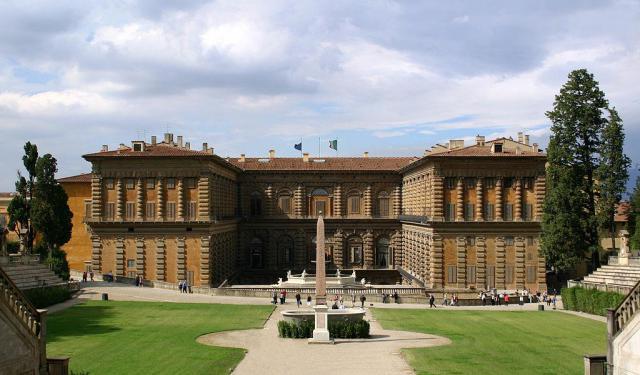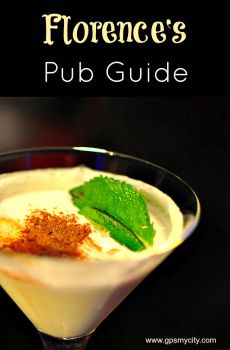Audio Guide: Florence Introduction Walking Tour (Self Guided), Florence
Florence was founded in 59 BC by Julius Caesar as a settlement for his veteran soldiers. Laid out like a Roman military camp, its main roads intersected at what is now the Republic Square. Originally named Fluentia, referencing its location between two rivers, the city later adopted the name Florentia, meaning “flowering” or “flourishing”.
And flourish it did. During the Middle Ages and well into the Renaissance, Florence grew into one of Europe’s wealthiest and most influential cities. From the 14th to 16th centuries, it emerged as a powerhouse of art, commerce, politics, and finance-and today, it's widely regarded as the birthplace of the Renaissance.
Many of the city’s most important landmarks were built during that golden era. Chief among them is the majestic Cathedral of Santa Maria del Fiore, crowned by its record-breaking dome-a masterpiece of engineering still unmatched after six centuries. Nearby stands the Giotto-designed Bell Tower, and just a short walk away is the Old Palace, Florence’s imposing town hall. Together, they shape the city’s unmistakable skyline.
What makes Florence truly special for visitors is the compact layout. Within walking distance, you’ll find treasures like the Uffizi Gallery, home to some of the world’s greatest artworks; the Pitti Palace, once the seat of Medici power; Michelangelo Square, perfect for sunset views; and the San Miniato Basilica, perched high above the city. You can also discover other stunning places like the peaceful Boboli Gardens or the Bargello Museum, housed in a medieval fortress.
Florence has endured its share of turmoil-from serving as the capital of the newly unified Italy in the 19th century to surviving bombings in World War II. And yet, its spirit has remained intact. In 1982, its historic center was recognized as a UNESCO World Heritage Site, honoring centuries of resilience and creativity.
Ready to discover the heart of the Renaissance? Our self-guided walking tour will take you through the city’s most unforgettable sights-from world-famous masterpieces to quiet corners rich in history. Lace up your shoes, bring your curiosity, and let the city’s timeless beauty unfold before you.
And flourish it did. During the Middle Ages and well into the Renaissance, Florence grew into one of Europe’s wealthiest and most influential cities. From the 14th to 16th centuries, it emerged as a powerhouse of art, commerce, politics, and finance-and today, it's widely regarded as the birthplace of the Renaissance.
Many of the city’s most important landmarks were built during that golden era. Chief among them is the majestic Cathedral of Santa Maria del Fiore, crowned by its record-breaking dome-a masterpiece of engineering still unmatched after six centuries. Nearby stands the Giotto-designed Bell Tower, and just a short walk away is the Old Palace, Florence’s imposing town hall. Together, they shape the city’s unmistakable skyline.
What makes Florence truly special for visitors is the compact layout. Within walking distance, you’ll find treasures like the Uffizi Gallery, home to some of the world’s greatest artworks; the Pitti Palace, once the seat of Medici power; Michelangelo Square, perfect for sunset views; and the San Miniato Basilica, perched high above the city. You can also discover other stunning places like the peaceful Boboli Gardens or the Bargello Museum, housed in a medieval fortress.
Florence has endured its share of turmoil-from serving as the capital of the newly unified Italy in the 19th century to surviving bombings in World War II. And yet, its spirit has remained intact. In 1982, its historic center was recognized as a UNESCO World Heritage Site, honoring centuries of resilience and creativity.
Ready to discover the heart of the Renaissance? Our self-guided walking tour will take you through the city’s most unforgettable sights-from world-famous masterpieces to quiet corners rich in history. Lace up your shoes, bring your curiosity, and let the city’s timeless beauty unfold before you.
How it works: Download the app "GPSmyCity: Walks in 1K+ Cities" from Apple App Store or Google Play Store to your mobile phone or tablet. The app turns your mobile device into a personal tour guide and its built-in GPS navigation functions guide you from one tour stop to next. The app works offline, so no data plan is needed when traveling abroad.
Florence Introduction Walking Tour Map
Guide Name: Florence Introduction Walking Tour
Guide Location: Italy » Florence (See other walking tours in Florence)
Guide Type: Self-guided Walking Tour (Sightseeing)
# of Attractions: 13
Tour Duration: 2 Hour(s)
Travel Distance: 4.1 Km or 2.5 Miles
Author: greghasleft
Sight(s) Featured in This Guide:
Guide Location: Italy » Florence (See other walking tours in Florence)
Guide Type: Self-guided Walking Tour (Sightseeing)
# of Attractions: 13
Tour Duration: 2 Hour(s)
Travel Distance: 4.1 Km or 2.5 Miles
Author: greghasleft
Sight(s) Featured in This Guide:
- Cattedrale di Santa Maria del Fiore (Florence Cathedral)
- Campanile di Giotto (Giotto's Bell Tower)
- Casa di Dante (Dante House-Museum)
- Palazzo del Bargello (Bargello National Museum)
- Piazza della Signoria (Signoria Square)
- Palazzo Vecchio (Old Palace)
- Galleria degli Uffizi (Uffizi Gallery)
- Ponte Vecchio (Old Bridge)
- Palazzo Pitti (Pitti Palace)
- Giardino di Boboli (Boboli Gardens)
- Forte di Belvedere (Fort Belvedere)
- Piazzale Michelangelo (Michelangelo Square)
- Basilica di San Miniato al Monte (Basilica of St. Minias on the Mountain)
1) Cattedrale di Santa Maria del Fiore (Florence Cathedral) (must see)
Towering over the city of Florence, the Florence Cathedral is a true Renaissance masterpiece-best known for its massive masonry dome, the largest of its kind in the world. Completed in 1465, this remarkable double-shell structure is entirely self-supporting and remains one of the greatest engineering marvels of its time.
The cathedral’s story begins in 1296, when construction of its Gothic design first got underway. The real breakthrough, however, came nearly 150 years later, when architect Filippo Brunelleschi stepped in to solve what many thought was an impossible challenge-building the dome. Inspired by the ancient Pantheon in Rome, Brunelleschi ran countless experiments using large-scale models and even invented custom machinery to get the job done.
Among his most remarkable inventions were lifting devices and pulley systems capable of raising over 37,000 tons of materials-including more than four million bricks. His work impressed a young apprentice named Leonardo da Vinci, who sketched the machines-drawings that were later mistakenly credited to him. But history has remembered the true innovator. Today, Brunelleschi’s statue stands in the piazza outside the Cathedral as a tribute to his genius.
Step inside, and you’ll find more treasures-like the fresco “Dante and the Divine Comedy” by Domenico di Michelino, painted in 1465. It shows the poet holding his famous book, surrounded by vivid imagery of Hell, Purgatory, and Heaven, along with a detailed view of Florence as it looked in the 15th century-ironically, a version of the city Dante himself never saw. To see it up close, be prepared to climb about 450 steps up a narrow staircase that spirals inside the dome.
And then there's the exterior-a stunning patchwork of colorful marbles so intricate it almost looks painted. The craftsmanship is nothing short of extraordinary.
Tip: When booking online, you’ll get free access to the top of the dome-but you’ll need to reserve a time slot separately. The reward is a 360-degree view of Florence, the Tuscan countryside, and the mountains beyond. Totally worth the climb.
The cathedral’s story begins in 1296, when construction of its Gothic design first got underway. The real breakthrough, however, came nearly 150 years later, when architect Filippo Brunelleschi stepped in to solve what many thought was an impossible challenge-building the dome. Inspired by the ancient Pantheon in Rome, Brunelleschi ran countless experiments using large-scale models and even invented custom machinery to get the job done.
Among his most remarkable inventions were lifting devices and pulley systems capable of raising over 37,000 tons of materials-including more than four million bricks. His work impressed a young apprentice named Leonardo da Vinci, who sketched the machines-drawings that were later mistakenly credited to him. But history has remembered the true innovator. Today, Brunelleschi’s statue stands in the piazza outside the Cathedral as a tribute to his genius.
Step inside, and you’ll find more treasures-like the fresco “Dante and the Divine Comedy” by Domenico di Michelino, painted in 1465. It shows the poet holding his famous book, surrounded by vivid imagery of Hell, Purgatory, and Heaven, along with a detailed view of Florence as it looked in the 15th century-ironically, a version of the city Dante himself never saw. To see it up close, be prepared to climb about 450 steps up a narrow staircase that spirals inside the dome.
And then there's the exterior-a stunning patchwork of colorful marbles so intricate it almost looks painted. The craftsmanship is nothing short of extraordinary.
Tip: When booking online, you’ll get free access to the top of the dome-but you’ll need to reserve a time slot separately. The reward is a 360-degree view of Florence, the Tuscan countryside, and the mountains beyond. Totally worth the climb.
2) Campanile di Giotto (Giotto's Bell Tower) (must see)
The famous Bell Tower of Giotto is one of Florence’s most iconic landmarks. Though it stands beside the Cathedral, it’s actually a freestanding belfry, designed by the legendary artist and architect Giotto di Bondone-the very same Giotto who’s often credited as the first great figure of the Italian Renaissance. Rising to a height of 85 meters, this stunning structure is a remarkable example of Florentine Gothic architecture, adorned with sculptural details and colorful marble inlays in white, green, and red.
Sadly, Giotto passed away before the tower was completed, and two other architects had to carry on the work. Still, his artistic touch is unmistakable-from the marble patterns on the façade to the figurative cycle within the belfry. He may not have finished it, but his vision set the tone for everything that followed.
Yes, you can climb the tower-and of the three major ones in Florence, this one is actually the easiest to scale. The staircase has 414 steps, but they’re well spaced, with rest areas between levels. Each stop reveals one of the seven bells inside-one for each note on the musical scale. Unlike the often-crowded Cathedral, this famous landmark feels more open, with room to pause, catch your breath, and enjoy the views.
And those views are something else. From the top, you’ll get a rare angle on the Cathedral’s dome, a neat view of the Baptistery, and a sweeping look across the city’s red-tiled rooftops and winding streets-many of which have barely changed in centuries.
Tip: Your combo ticket for the Florence Cathedral complex includes access to the Bell Tower-no reservation needed. Once activated, the ticket is valid for 72 hours, giving you plenty of time to visit the other sites. While you may have to wait in line, the queue for the tower is usually short and moves quickly.
Sadly, Giotto passed away before the tower was completed, and two other architects had to carry on the work. Still, his artistic touch is unmistakable-from the marble patterns on the façade to the figurative cycle within the belfry. He may not have finished it, but his vision set the tone for everything that followed.
Yes, you can climb the tower-and of the three major ones in Florence, this one is actually the easiest to scale. The staircase has 414 steps, but they’re well spaced, with rest areas between levels. Each stop reveals one of the seven bells inside-one for each note on the musical scale. Unlike the often-crowded Cathedral, this famous landmark feels more open, with room to pause, catch your breath, and enjoy the views.
And those views are something else. From the top, you’ll get a rare angle on the Cathedral’s dome, a neat view of the Baptistery, and a sweeping look across the city’s red-tiled rooftops and winding streets-many of which have barely changed in centuries.
Tip: Your combo ticket for the Florence Cathedral complex includes access to the Bell Tower-no reservation needed. Once activated, the ticket is valid for 72 hours, giving you plenty of time to visit the other sites. While you may have to wait in line, the queue for the tower is usually short and moves quickly.
3) Casa di Dante (Dante House-Museum)
Florence underwent dramatic changes during the Renaissance, but in the city’s eastern quarter, you can still feel the spirit of the Middle Ages. Winding your way through its narrow alleys and tucked-away corners, you’ll find yourself stepping into scenes that Florence’s most famous poet, Dante Alighieri, would recognize even today. Not far from the parish church where he first laid eyes on Beatrice Portinari, his lifelong muse, stands Casa di Dante, the house believed to be his childhood home.
Now a three-story museum, the space offers a thoughtful look at the life and legacy of the man behind the “Divine Comedy”. On the ground floor, you’ll explore his early years in Florence. The second level focuses on the turning point of his life-the exile-and the time he spent in Ravenna, where he eventually died. Climb to the top floor, and you’ll find a collection of the poet’s personal items, along with replicas carefully recreated to reflect his world. One standout piece is a miniature edition of the “Divina Comedia”-the smallest printed version of the famous text, and a testament to its enduring legacy.
Dante’s epic poem takes the reader on a journey through the afterlife-guided first by the Roman poet Virgil through Hell and Purgatory, then by Beatrice through the realms of Paradise. Though Dante himself called the work simply "The Comedy," it gained popularity over the centuries, and in 1555, a lavish edition published in Venice gave us the name we know today.
Tip: The museum’s staircase is quite steep, but there is an elevator-just note that it’s a bit tucked away and might not be obvious when you first walk in. Keep an eye out, especially if you're hoping to skip the stairs.
Now a three-story museum, the space offers a thoughtful look at the life and legacy of the man behind the “Divine Comedy”. On the ground floor, you’ll explore his early years in Florence. The second level focuses on the turning point of his life-the exile-and the time he spent in Ravenna, where he eventually died. Climb to the top floor, and you’ll find a collection of the poet’s personal items, along with replicas carefully recreated to reflect his world. One standout piece is a miniature edition of the “Divina Comedia”-the smallest printed version of the famous text, and a testament to its enduring legacy.
Dante’s epic poem takes the reader on a journey through the afterlife-guided first by the Roman poet Virgil through Hell and Purgatory, then by Beatrice through the realms of Paradise. Though Dante himself called the work simply "The Comedy," it gained popularity over the centuries, and in 1555, a lavish edition published in Venice gave us the name we know today.
Tip: The museum’s staircase is quite steep, but there is an elevator-just note that it’s a bit tucked away and might not be obvious when you first walk in. Keep an eye out, especially if you're hoping to skip the stairs.
4) Palazzo del Bargello (Bargello National Museum) (must see)
Florence is a haven for architecture enthusiasts and art lovers, and the Bargello Museum elevates this experience even further. Set within the walls of a medieval fortress, the museum houses some of Italy’s most prized sculptures and artworks.
Also known as the People’s Palace, the Bargello dates back to 1255, making it one of Florence’s oldest surviving structures. Over the centuries, it’s served many roles-starting in the 16th century, when it housed Florence’s chief of police, also called the “bargello.” Later, it functioned as a prison before finally being transformed into a museum in the mid-19th century. Since then, it’s become the ultimate destination for Gothic and Renaissance sculpture.
Inside, you’ll encounter masterpieces by iconic artists like Michelangelo, Donatello, Verrocchio, and Brunelleschi, to name just a few. One of the museum’s most celebrated pieces is Donatello’s “David”, a landmark work that became the first male nude sculpture publicly displayed since ancient times-marking a turning point in European art. Michelangelo’s contributions include “Bacchus”, “Pitti Tondo” (also known as “Madonna and Child”), “Brutus”, and “David-Apollo”. “Bacchus”, which Michelangelo carved at just 22 years old, is particularly striking. The figure’s rolling eyes and teetering posture give it an almost lifelike instability, reflecting a daringly androgynous quality that marked a bold step in the artist’s early career.
Beyond the Renaissance sculptures, the museum offers treasures from the Byzantine, Roman, and Medieval periods. You’ll also find exquisite jewelry-some pieces from the European Renaissance, others with Islamic origins. English descriptions accompany all exhibits, making the experience both accessible and informative.
Tip: Check the museum’s website ahead of time for opening hours. On certain days, the Bargello stays open late, giving visitors the chance to explore the medieval setting in a peaceful, near-empty atmosphere. It’s an unforgettable way to experience these works of art.
Also known as the People’s Palace, the Bargello dates back to 1255, making it one of Florence’s oldest surviving structures. Over the centuries, it’s served many roles-starting in the 16th century, when it housed Florence’s chief of police, also called the “bargello.” Later, it functioned as a prison before finally being transformed into a museum in the mid-19th century. Since then, it’s become the ultimate destination for Gothic and Renaissance sculpture.
Inside, you’ll encounter masterpieces by iconic artists like Michelangelo, Donatello, Verrocchio, and Brunelleschi, to name just a few. One of the museum’s most celebrated pieces is Donatello’s “David”, a landmark work that became the first male nude sculpture publicly displayed since ancient times-marking a turning point in European art. Michelangelo’s contributions include “Bacchus”, “Pitti Tondo” (also known as “Madonna and Child”), “Brutus”, and “David-Apollo”. “Bacchus”, which Michelangelo carved at just 22 years old, is particularly striking. The figure’s rolling eyes and teetering posture give it an almost lifelike instability, reflecting a daringly androgynous quality that marked a bold step in the artist’s early career.
Beyond the Renaissance sculptures, the museum offers treasures from the Byzantine, Roman, and Medieval periods. You’ll also find exquisite jewelry-some pieces from the European Renaissance, others with Islamic origins. English descriptions accompany all exhibits, making the experience both accessible and informative.
Tip: Check the museum’s website ahead of time for opening hours. On certain days, the Bargello stays open late, giving visitors the chance to explore the medieval setting in a peaceful, near-empty atmosphere. It’s an unforgettable way to experience these works of art.
5) Piazza della Signoria (Signoria Square) (must see)
Alongside the Cathedral Square-the religious heart of Florence-you’ll find Signoria Square, the city’s historic civic center and a living museum under the open sky. Framed by elegant buildings and top-tier museums, this spot holds a special place in the hearts of locals. It was here that the Florentine Republic took shape, and to this day, the area remains a cherished gathering place. Michelangelo’s original “David” once stood proudly in the square, and while that statue now resides in a museum, a faithful replica now stands in its place, keeping the legacy alive.
Long before the Renaissance, back in Roman times, this was the town center of Florentia, surrounded by a theater, public baths, and a textile workshop. Centuries later, a church, a loggia, and a vast 5th-century basilica rose here, traces of which came to light during excavations in the 1980s.
What makes the square truly captivating is its irregular shape and the wealth of artwork-both monumental and subtle-that surrounds you. It’s a dream for photographers, with striking visuals from every angle. But even without a camera, just standing at the center and slowly turning to take it all in is a moment worth savoring.
Presiding over everything is the medieval Old Palace, still the seat of city government. Nearby, you’ll find the Lanterns’ Lodge-an open-air sculpture gallery that’s free to enter and always open. Here you’ll see dramatic masterpieces like “The Rape of the Sabine Women”, “Hercules and the Centaur”, and “Perseus with the Head of Medusa”, which seems locked in a timeless stare with Michelangelo’s “David”.
There are a few shaded benches for a break, but if you're visiting in summer, take it slow and stay hydrated. The crowds can be thick, so when crossing the square, don’t aim straight-zigzag gently, like a sailboat tacking through the wind. A few graceful steps to the right, a few to the left, and before you know it, you’re there. Simple, smooth, and very Florentine.
Long before the Renaissance, back in Roman times, this was the town center of Florentia, surrounded by a theater, public baths, and a textile workshop. Centuries later, a church, a loggia, and a vast 5th-century basilica rose here, traces of which came to light during excavations in the 1980s.
What makes the square truly captivating is its irregular shape and the wealth of artwork-both monumental and subtle-that surrounds you. It’s a dream for photographers, with striking visuals from every angle. But even without a camera, just standing at the center and slowly turning to take it all in is a moment worth savoring.
Presiding over everything is the medieval Old Palace, still the seat of city government. Nearby, you’ll find the Lanterns’ Lodge-an open-air sculpture gallery that’s free to enter and always open. Here you’ll see dramatic masterpieces like “The Rape of the Sabine Women”, “Hercules and the Centaur”, and “Perseus with the Head of Medusa”, which seems locked in a timeless stare with Michelangelo’s “David”.
There are a few shaded benches for a break, but if you're visiting in summer, take it slow and stay hydrated. The crowds can be thick, so when crossing the square, don’t aim straight-zigzag gently, like a sailboat tacking through the wind. A few graceful steps to the right, a few to the left, and before you know it, you’re there. Simple, smooth, and very Florentine.
6) Palazzo Vecchio (Old Palace) (must see)
Just like the Cathedral complex and Florence’s world-class galleries, the Old Palace is essential for anyone wanting to grasp the city's history and cultural identity. This massive Romanesque fortress is one of the most striking town halls in all of Tuscany. Since 1872, it has served as the office of Florence’s mayor, but its legacy stretches much further back. Built in 1299, the edifice was the political heart of the Florentine Republic for centuries. When Cosimo de’ Medici moved in with his family in 1540 as Grand Duke, he had it expanded and transformed, blending its medieval bones with elegant Renaissance flair.
The rugged stone façade, lined with shields chronicling Florence’s political past, is also home to an impressive lineup of statues. These include Florence’s heraldic symbol- the Marzocco lion, along with Donatello’s powerful “Judith and Holofernes”, and “Hercules and Cacus”. The nearby Tower of Arnolfo, rising above the palace, offers a climbable vantage point-though access requires a separate ticket.
Meanwhile, inside, every room tells a chapter of the city’s history. You’ll walk through the spectacular Hall of the Five Hundred, designed to glorify Medici rule, and into the more private quarters where the family lived. Decorated under the artistic direction of Giorgio Vasari, these spaces are rich in symbolism and political narrative. Give yourself time to move slowly through the rooms-it’s an immersive dive into Florentine grandeur. And be warned: you may leave with a crick in your neck from gazing.
One standout work here is Michelangelo’s “Genius of Victory”. Originally meant for the tomb of Pope Julius II, the sculpture depicts a young, triumphant figure standing over a defeated older man. The contrast between the two is striking-the victor is smooth and polished, the vanquished figure unfinished and rough, still bearing the weight of the stone.
You’ll also come across something rather haunting-a death mask of Dante Alighieri, displayed between the Apartments of Eleanor and the Halls of the Priors. Though the poet was buried in Ravenna, this plaster cast has become a powerful reminder of his influence on Florence, both politically and culturally. Fans of Dan Brown’s “Inferno” will surely recognize it from the novel.
Tip: If you’re planning a guided visit, it’s best to book directly with the museum by email-include your preferred date and time, and wait for confirmation. Payment is made on the day of your tour, and afterward, you’re free to continue exploring on your own. Just keep in mind: because this is still a working municipal building, access may occasionally be restricted. It’s a good idea to check the official website before you go.
The rugged stone façade, lined with shields chronicling Florence’s political past, is also home to an impressive lineup of statues. These include Florence’s heraldic symbol- the Marzocco lion, along with Donatello’s powerful “Judith and Holofernes”, and “Hercules and Cacus”. The nearby Tower of Arnolfo, rising above the palace, offers a climbable vantage point-though access requires a separate ticket.
Meanwhile, inside, every room tells a chapter of the city’s history. You’ll walk through the spectacular Hall of the Five Hundred, designed to glorify Medici rule, and into the more private quarters where the family lived. Decorated under the artistic direction of Giorgio Vasari, these spaces are rich in symbolism and political narrative. Give yourself time to move slowly through the rooms-it’s an immersive dive into Florentine grandeur. And be warned: you may leave with a crick in your neck from gazing.
One standout work here is Michelangelo’s “Genius of Victory”. Originally meant for the tomb of Pope Julius II, the sculpture depicts a young, triumphant figure standing over a defeated older man. The contrast between the two is striking-the victor is smooth and polished, the vanquished figure unfinished and rough, still bearing the weight of the stone.
You’ll also come across something rather haunting-a death mask of Dante Alighieri, displayed between the Apartments of Eleanor and the Halls of the Priors. Though the poet was buried in Ravenna, this plaster cast has become a powerful reminder of his influence on Florence, both politically and culturally. Fans of Dan Brown’s “Inferno” will surely recognize it from the novel.
Tip: If you’re planning a guided visit, it’s best to book directly with the museum by email-include your preferred date and time, and wait for confirmation. Payment is made on the day of your tour, and afterward, you’re free to continue exploring on your own. Just keep in mind: because this is still a working municipal building, access may occasionally be restricted. It’s a good idea to check the official website before you go.
7) Galleria degli Uffizi (Uffizi Gallery) (must see)
If you could only visit one Renaissance landmark in Florence-or even the entire world-the Uffizi Gallery would be the top contender. Originally designed as government offices for the magistrates of Florence, this grand building was commissioned in the 16th century by Cosimo de’ Medici and brought to life by Giorgio Vasari. Though built for administrative purposes, the palace quickly evolved into the perfect setting for the Medici family’s extraordinary art collection. By 1765, the gallery opened its doors to the public and has since become one of Florence’s most visited museums.
Here, you’ll come face-to-face with some of the most iconic works in art history. Highlights include Sandro Botticelli’s “Birth of Venus” and “Adoration of the Magi”, as well as masterpieces by Leonardo da Vinci, Michelangelo, and Caravaggio. One of Michelangelo’s works displayed is “Doni Tondo”-a circular painting nearly four feet across that depicts the Holy Family. Created in 1504, it gives us an early glimpse of the vibrant palette the artist would later use in his frescoes on the Sistine Chapel ceiling.
While paintings and sculptures are the main attraction, don’t overlook the gallery’s interior design. The ceilings are intricately decorated, and each room carries its own sense of grandeur. With more than 50 opulent rooms to wander through, it’s easy to feel overwhelmed. That’s why a break at the rooftop café is a smart move. Grab a coffee, rest your feet, and soak in the stunning views of Florence that you won’t find anywhere else.
Because of its global fame, the Uffizi is rarely quiet. Expect long lines, especially during high season. Booking your ticket in advance through the official website is highly recommended-it will save you time, and you might even catch a discount. And one last note before you go: no liquids are allowed inside, so plan accordingly.
Here, you’ll come face-to-face with some of the most iconic works in art history. Highlights include Sandro Botticelli’s “Birth of Venus” and “Adoration of the Magi”, as well as masterpieces by Leonardo da Vinci, Michelangelo, and Caravaggio. One of Michelangelo’s works displayed is “Doni Tondo”-a circular painting nearly four feet across that depicts the Holy Family. Created in 1504, it gives us an early glimpse of the vibrant palette the artist would later use in his frescoes on the Sistine Chapel ceiling.
While paintings and sculptures are the main attraction, don’t overlook the gallery’s interior design. The ceilings are intricately decorated, and each room carries its own sense of grandeur. With more than 50 opulent rooms to wander through, it’s easy to feel overwhelmed. That’s why a break at the rooftop café is a smart move. Grab a coffee, rest your feet, and soak in the stunning views of Florence that you won’t find anywhere else.
Because of its global fame, the Uffizi is rarely quiet. Expect long lines, especially during high season. Booking your ticket in advance through the official website is highly recommended-it will save you time, and you might even catch a discount. And one last note before you go: no liquids are allowed inside, so plan accordingly.
8) Ponte Vecchio (Old Bridge) (must see)
Ponte Vecchio, or The Old Bridge, first appeared in written records all the way back in 996. Of the six bridges that span the Arno River in Florence, it’s the only one that survived World War II intact-spared by retreating German forces. Today, this medieval stone arch structure stands as a powerful reminder of how a ruler’s vision can shape a city’s legacy.
As in the Middle Ages, the bridge is still lined with shops-but what’s sold here has changed quite a bit over time. Originally, it was occupied by butchers, who were know for tossing animal waste directly into the river-hardly ideal for anyone strolling by. That all changed in the 16th century, when Grand Duke Ferdinando de’ Medici had the meat merchants removed and replaced with goldsmiths. Not only did this improve the smell, but it also turned the bridge into one of the most glittering, upscale corners of Florence.
Take a look from a distance, and you might spot something unusual-a raised corridor running above the shops. This hidden passage is part of the Vasari Corridor, a nearly kilometer-long tunnel that connects the Pitti Palace with the Old Palace. It was built so that the Grand Duke could move between his residence and government offices without mingling with the crowds. Although closed since 2016 for safety reasons, there are plans to reopen it for visitors.
There’s even a bit of financial folklore tied to this spot, which is said to be the birthplace of the term “bankruptcy.” When a moneylender couldn’t pay his debts, soldiers smashed his trading bench-called a banco-to pieces, a symbolic act that left him unable to operate. Hence the term “bancorotto”, or “broken bench”, was born.
These days, the Old Bridge is a lovely place for a walk-especially at sunset, when the light casts a golden glow over the Arno. Early mornings are just as magical, with soft reflections on the water and, if you’re lucky, the bridge nearly all to yourself.
As in the Middle Ages, the bridge is still lined with shops-but what’s sold here has changed quite a bit over time. Originally, it was occupied by butchers, who were know for tossing animal waste directly into the river-hardly ideal for anyone strolling by. That all changed in the 16th century, when Grand Duke Ferdinando de’ Medici had the meat merchants removed and replaced with goldsmiths. Not only did this improve the smell, but it also turned the bridge into one of the most glittering, upscale corners of Florence.
Take a look from a distance, and you might spot something unusual-a raised corridor running above the shops. This hidden passage is part of the Vasari Corridor, a nearly kilometer-long tunnel that connects the Pitti Palace with the Old Palace. It was built so that the Grand Duke could move between his residence and government offices without mingling with the crowds. Although closed since 2016 for safety reasons, there are plans to reopen it for visitors.
There’s even a bit of financial folklore tied to this spot, which is said to be the birthplace of the term “bankruptcy.” When a moneylender couldn’t pay his debts, soldiers smashed his trading bench-called a banco-to pieces, a symbolic act that left him unable to operate. Hence the term “bancorotto”, or “broken bench”, was born.
These days, the Old Bridge is a lovely place for a walk-especially at sunset, when the light casts a golden glow over the Arno. Early mornings are just as magical, with soft reflections on the water and, if you’re lucky, the bridge nearly all to yourself.
9) Palazzo Pitti (Pitti Palace) (must see)
The Pitti Palace is one of Florence’s grandest landmarks-missing it would be like skipping a chapter in the city’s history. This massive 15th-century residence is a celebration of Renaissance architecture, and its vast gardens, full of winding paths and hidden corners, offer a new surprise with every turn.
Originally built for the powerful Medici family, the palace served as their official residence from the 16th to the 18th century. After the Medici dynasty ended, the property passed to the House of Lorraine, and later, Napoleon Bonaparte used it as a stronghold during his rule over Italy. Today, the palace houses a remarkable collection of museums- yet, it still holds what may be the richest concentration of Medici art and history. Alongside priceless paintings are beautifully preserved furnishings and interior details that once belonged to the family.
Every part of the palace reflects elegance and power-from the Palatine Gallery, with over 500 Renaissance paintings, to the opulent Royal Apartments, the glittering Medici Treasury, and the Gallery of Costume and Fashion. You’ll also find specialized museums showcasing porcelain and royal carriages, offering a different glimpse into court life.
In short, although it’s been state property since 1919, the palace still carries the atmosphere of a private royal home. And with over 5 million visitors each year, it remains one of Florence’s most admired cultural spots.
Tip: A combo ticket gives you access to both the museums and the gardens for two full days-plenty of time to explore at a relaxed pace. If you plan to spend a few hours in the gardens, don’t forget a hat and water, especially in warmer months. To avoid waiting in long lines at the entrance, booking a guided tour is a smart move. Yes, there's an added cost, but you'll skip the queue and get deeper insights into this piece of Florentine history.
Originally built for the powerful Medici family, the palace served as their official residence from the 16th to the 18th century. After the Medici dynasty ended, the property passed to the House of Lorraine, and later, Napoleon Bonaparte used it as a stronghold during his rule over Italy. Today, the palace houses a remarkable collection of museums- yet, it still holds what may be the richest concentration of Medici art and history. Alongside priceless paintings are beautifully preserved furnishings and interior details that once belonged to the family.
Every part of the palace reflects elegance and power-from the Palatine Gallery, with over 500 Renaissance paintings, to the opulent Royal Apartments, the glittering Medici Treasury, and the Gallery of Costume and Fashion. You’ll also find specialized museums showcasing porcelain and royal carriages, offering a different glimpse into court life.
In short, although it’s been state property since 1919, the palace still carries the atmosphere of a private royal home. And with over 5 million visitors each year, it remains one of Florence’s most admired cultural spots.
Tip: A combo ticket gives you access to both the museums and the gardens for two full days-plenty of time to explore at a relaxed pace. If you plan to spend a few hours in the gardens, don’t forget a hat and water, especially in warmer months. To avoid waiting in long lines at the entrance, booking a guided tour is a smart move. Yes, there's an added cost, but you'll skip the queue and get deeper insights into this piece of Florentine history.
10) Giardino di Boboli (Boboli Gardens)
Tucked behind the grand Pitti Palace, the Boboli Gardens are among the most exquisite and historically rich green spaces in Europe. First designed in the 16th century at the request of Eleonora di Toledo, wife of Cosimo de Medici, the gardens brought together some of the finest landscape architects of the era. Their combined vision gave rise to one of the earliest and most complete examples of Mannerist landscape design-a style that pushed beyond the harmony of the Renaissance to create something more elaborate and full of visual surprises.
What makes these gardens remarkable is their bold design. Wide gravel paths stretch out in long, symmetrical lines, flanked by stonework, fountains, and statues. Classical elements like grottos, nymphaea, and temple-like structures are scattered throughout, offering intricate detail at every turn. Unlike the enclosed, private gardens typical of the time, Boboli’s layout is open, inviting sweeping views over Florence. This openness later served as a model for many European royal gardens-including Versailles.
Over the centuries, the grounds have been expanded and reimagined, now covering around 11 acres. Walking through them feels like stepping into an open-air museum, where you’ll come across works of art, ancient sculptures, and artifacts dating back to the Roman period and the 16th–17th centuries.
For those craving a break from the crowds and the pace of the city, this is the perfect place to unwind. While the entrance fee might seem a bit high, the peaceful atmosphere, artistic beauty, and panoramic city views make it more than worthwhile. Consider bringing a picnic and staying a while-though be prepared for some uphill paths and stairs along the way. There are several suggested walking routes, including easier options for a more relaxed visit.
Tip: Entry is covered by the FirenzeCard, and cardholders can skip the lines by heading straight to the bookshop inside the Pitti Palace. Plan to spend about two hours exploring, and don’t forget your water, snacks, and good walking shoes to keep you going.
What makes these gardens remarkable is their bold design. Wide gravel paths stretch out in long, symmetrical lines, flanked by stonework, fountains, and statues. Classical elements like grottos, nymphaea, and temple-like structures are scattered throughout, offering intricate detail at every turn. Unlike the enclosed, private gardens typical of the time, Boboli’s layout is open, inviting sweeping views over Florence. This openness later served as a model for many European royal gardens-including Versailles.
Over the centuries, the grounds have been expanded and reimagined, now covering around 11 acres. Walking through them feels like stepping into an open-air museum, where you’ll come across works of art, ancient sculptures, and artifacts dating back to the Roman period and the 16th–17th centuries.
For those craving a break from the crowds and the pace of the city, this is the perfect place to unwind. While the entrance fee might seem a bit high, the peaceful atmosphere, artistic beauty, and panoramic city views make it more than worthwhile. Consider bringing a picnic and staying a while-though be prepared for some uphill paths and stairs along the way. There are several suggested walking routes, including easier options for a more relaxed visit.
Tip: Entry is covered by the FirenzeCard, and cardholders can skip the lines by heading straight to the bookshop inside the Pitti Palace. Plan to spend about two hours exploring, and don’t forget your water, snacks, and good walking shoes to keep you going.
11) Forte di Belvedere (Fort Belvedere)
Fort Belvedere is a striking example of both Italian Renaissance elegance and strategic military design. Built at the end of the 16th century by Grand Duke Ferdinando de’ Medici, the fortress had a dual mission: to protect Florence and to demonstrate the might and wealth of the Medici family. It also served as a secure vault for their treasury and provided a refuge for the Grand Duke during times of unrest or siege.
To allow safe and quick movement, the fort was smartly connected to key spots in the city-like the Old Palace, the Pitti Palace, and the Boboli Gardens-through a network of hidden passageways. Positioned high above Florence, this landmark offered an ideal lookout over the surrounding area. During the Renaissance, fortifications were critical to military strategy. Belvedere’s angled walls were designed for both surveillance and defense, allowing for overlapping lines of fire to protect each section. Interestingly, the great Galileo Galilei once used the site for his astronomical studies. After being sentenced to life imprisonment in 1633, he lived nearby at Villa Arcetri, just beyond the walls.
At the heart of the fort lies a luxurious villa, completed around 1570-before the fortress itself. Meant to shelter the Grand Duke during crises or epidemics, this residence was built for comfort rather than defense. Legend has it the Medici treasures were hidden at the bottom of a heavily guarded well, rigged with traps that would spring on any intruder foolish enough to tamper with the locks.
Following a restoration, Fort Belvedere reopened in 2013, now serving mainly as a cultural venue and exhibition space. The small entrance fee grants access to sweeping views of Florence and the surrounding Tuscan hills-truly one of the city's best panoramic spots.
Tip: Head up to the upper floor for a cozy café-perfect for a relaxed lunch or a cool drink with a view.
To allow safe and quick movement, the fort was smartly connected to key spots in the city-like the Old Palace, the Pitti Palace, and the Boboli Gardens-through a network of hidden passageways. Positioned high above Florence, this landmark offered an ideal lookout over the surrounding area. During the Renaissance, fortifications were critical to military strategy. Belvedere’s angled walls were designed for both surveillance and defense, allowing for overlapping lines of fire to protect each section. Interestingly, the great Galileo Galilei once used the site for his astronomical studies. After being sentenced to life imprisonment in 1633, he lived nearby at Villa Arcetri, just beyond the walls.
At the heart of the fort lies a luxurious villa, completed around 1570-before the fortress itself. Meant to shelter the Grand Duke during crises or epidemics, this residence was built for comfort rather than defense. Legend has it the Medici treasures were hidden at the bottom of a heavily guarded well, rigged with traps that would spring on any intruder foolish enough to tamper with the locks.
Following a restoration, Fort Belvedere reopened in 2013, now serving mainly as a cultural venue and exhibition space. The small entrance fee grants access to sweeping views of Florence and the surrounding Tuscan hills-truly one of the city's best panoramic spots.
Tip: Head up to the upper floor for a cozy café-perfect for a relaxed lunch or a cool drink with a view.
12) Piazzale Michelangelo (Michelangelo Square) (must see)
Florence is undebiably a stunning city, and this hilltop terrace proves it beyond question. Perched just south of the Arno River, the spacious overlook is lined with souvenir stalls and draws crowds for its panoramas of the city’s red-tiled rooftops. From here, you’ll spot the majestic Cathedral and its dome, along with the Giotto Bell Tower and Old Palace-a postcard-perfect scene has been captured thousands of times. But there’s more to take in. Scan the horizon and you’ll also spot Fort Belvedere, the Holy Cross Basilica, and the timelessly charming Old Bridge.
The square was laid out in 1869, during a period of major urban development known as the “Risanamento,” when Florence briefly served as Italy’s capital. As the name suggests, it was meant to honor Michelangelo, and features bronze copies of his most famous works-“David”, along with the four allegorical figures from the Medici Chapel. While the originals are in marble, these replicas were hauled up the hill by nine pairs of oxen-no small feat, especially on a warm Tuscan day.
As evening sets in, the square becomes a magnet for sunset seekers. Find a comfortable spot, sip a glass of wine, and watch the sun paint the city in golden tones. You can bring your own bottle or choose one of the nearby cafés and restaurants. The most famous one here is housed in a lovely Neoclassical building, and surprisingly, the prices are pretty fair for such a prime location.
Halfway up the main staircase, you’ll also find the charming rose garden-a peaceful hideaway filled with greenery and floral scents, with views of the city peeking through the trees.
Tip: Sunny days can get quite hot up here, so be sure to pack a hat or something to shield yourself from the sun.
The square was laid out in 1869, during a period of major urban development known as the “Risanamento,” when Florence briefly served as Italy’s capital. As the name suggests, it was meant to honor Michelangelo, and features bronze copies of his most famous works-“David”, along with the four allegorical figures from the Medici Chapel. While the originals are in marble, these replicas were hauled up the hill by nine pairs of oxen-no small feat, especially on a warm Tuscan day.
As evening sets in, the square becomes a magnet for sunset seekers. Find a comfortable spot, sip a glass of wine, and watch the sun paint the city in golden tones. You can bring your own bottle or choose one of the nearby cafés and restaurants. The most famous one here is housed in a lovely Neoclassical building, and surprisingly, the prices are pretty fair for such a prime location.
Halfway up the main staircase, you’ll also find the charming rose garden-a peaceful hideaway filled with greenery and floral scents, with views of the city peeking through the trees.
Tip: Sunny days can get quite hot up here, so be sure to pack a hat or something to shield yourself from the sun.
13) Basilica di San Miniato al Monte (Basilica of St. Minias on the Mountain) (must see)
Sitting high above Florence on a scenic hill, San Miniato is praised as one of Tuscany’s finest examples of Romanesque architecture-and one of Italy’s most beautiful churches. While the climb can be a bit of a challenge, the experience pairs beautifully with a visit to Michelangelo Square just below, and best of all-there’s no entrance fee. You’ll gain access to both the basilica and the Olivetan monastery next door, still home to monks who care for the site.
The basilica is named after Minias, an Armenian prince who served in the Roman army under Emperor Decius. After becoming a hermit, he was denounced as a Christian. The emperor ordered him thrown to wild animals in the amphitheater-but, allegedly, wild beasts refused to harm him. Eventually, Miniato was beheaded in front of the emperor himself. The story goes that he then picked up his own head, crossed the Arno River, and walked to the top of the hill where he had lived in solitude. A shrine was later built here in his honor, followed by a chapel in the 8th century.
The current church was financed by Florence’s guild of cloth merchants, and their devotion shows. Inside, you’ll find stunning mosaic work, a beautifully crafted marble inlaid altar, and even a surprising astrological floor design that reflects medieval fascination with the heavens.
Just outside, you can wander through the unique and atmospheric cemetery, filled with ornate tombs and monuments. It’s also the burial site of Carlo Collodi, the author of “Pinocchio”. And don’t forget to step behind the basilica-the view of Florence from up there is simply unforgettable.
Before you leave, make time for a stop at the monastery shop, where the Olivetan monks sell a unique selection of herbal liqueurs, teas, honey, and medicinal tinctures-all made on-site using centuries-old recipes.
Tip: At 5:30pm, you’re welcome to join or simply observe the Mass, sung entirely in Latin and Italian by the priests. By 6:30, the monks gather to chant vespers, filling the space with their harmonies.
The basilica is named after Minias, an Armenian prince who served in the Roman army under Emperor Decius. After becoming a hermit, he was denounced as a Christian. The emperor ordered him thrown to wild animals in the amphitheater-but, allegedly, wild beasts refused to harm him. Eventually, Miniato was beheaded in front of the emperor himself. The story goes that he then picked up his own head, crossed the Arno River, and walked to the top of the hill where he had lived in solitude. A shrine was later built here in his honor, followed by a chapel in the 8th century.
The current church was financed by Florence’s guild of cloth merchants, and their devotion shows. Inside, you’ll find stunning mosaic work, a beautifully crafted marble inlaid altar, and even a surprising astrological floor design that reflects medieval fascination with the heavens.
Just outside, you can wander through the unique and atmospheric cemetery, filled with ornate tombs and monuments. It’s also the burial site of Carlo Collodi, the author of “Pinocchio”. And don’t forget to step behind the basilica-the view of Florence from up there is simply unforgettable.
Before you leave, make time for a stop at the monastery shop, where the Olivetan monks sell a unique selection of herbal liqueurs, teas, honey, and medicinal tinctures-all made on-site using centuries-old recipes.
Tip: At 5:30pm, you’re welcome to join or simply observe the Mass, sung entirely in Latin and Italian by the priests. By 6:30, the monks gather to chant vespers, filling the space with their harmonies.
Walking Tours in Florence, Italy
Create Your Own Walk in Florence
Creating your own self-guided walk in Florence is easy and fun. Choose the city attractions that you want to see and a walk route map will be created just for you. You can even set your hotel as the start point of the walk.
Arno South Bank Walking Tour
The area south of the Arno River-known as Oltrarno, or “Beyond the Arno”-offers a quieter, more intimate side of Florence, but one that’s no less captivating. It’s here that you’ll find the grand Pitti Palace, home to a painting collection rivaled only by the Uffizi Gallery, and the expansive Boboli Gardens, once the private domain of the Medici and later, the royal family. As one of the... view more
Tour Duration: 2 Hour(s)
Travel Distance: 2.4 Km or 1.5 Miles
Tour Duration: 2 Hour(s)
Travel Distance: 2.4 Km or 1.5 Miles
Michelangelo's Masterpieces Walking Tour
Though born in the small Tuscan town of Caprese, Michelangelo spent over two decades of his life in Florence-the heart of the Renaissance. It was here that he grew up, was educated, and began shaping his artistic voice, eventually creating some of the most iconic masterpieces the city has ever known.
His larger-than-life work-“David”-didn’t just reshape the image of biblical heroism-it... view more
Tour Duration: 2 Hour(s)
Travel Distance: 4.0 Km or 2.5 Miles
His larger-than-life work-“David”-didn’t just reshape the image of biblical heroism-it... view more
Tour Duration: 2 Hour(s)
Travel Distance: 4.0 Km or 2.5 Miles
Florence's Hidden Art Treasures
The “Cradle of the Renaissance,” Florence is one of Europe’s most beautiful and busiest destinations, home to some of the world's greatest pieces of art and architecture. The iconic masters like Giotto, Botticelli, Raphael and Michelangelo, as well as their somewhat less-known but equally talented counterparts, such as Ghirlandaio, Sangallo and Castagno, have blessed this city with... view more
Tour Duration: 2 Hour(s)
Travel Distance: 3.2 Km or 2 Miles
Tour Duration: 2 Hour(s)
Travel Distance: 3.2 Km or 2 Miles
Duomo Walking Tour
Right in the heart of historic Florence lies the Duomo district-the city's religious and civic core, and one of the most remarkable places in all of Italy. Between the Duomo and Signoria squares, Florence unfolds in layers of art, history, and architectural brilliance, offering a never-ending stream of things to see, do, and admire.
At the center of it all stands the Florence Cathedral, or... view more
Tour Duration: 2 Hour(s)
Travel Distance: 2.3 Km or 1.4 Miles
At the center of it all stands the Florence Cathedral, or... view more
Tour Duration: 2 Hour(s)
Travel Distance: 2.3 Km or 1.4 Miles
Florence Food Tour
Food is one of the great Florentine passions, and the great thing about having a delicious authentic Tuscan meal, a snack, delicatessen, or a quality gelato here – besides the abundant variety – is not having to spend a lot of money for it.
In general, the “osterias” and the eateries nestled in Sant’Ambrogio Market will offer cheaper and more casual food with an emphasis on home... view more
Tour Duration: 2 Hour(s)
Travel Distance: 2.6 Km or 1.6 Miles
In general, the “osterias” and the eateries nestled in Sant’Ambrogio Market will offer cheaper and more casual food with an emphasis on home... view more
Tour Duration: 2 Hour(s)
Travel Distance: 2.6 Km or 1.6 Miles
Medici Landmarks Walking Tour
The Medici family helped to establish Florence as the single most important art capital of Renaissance Europe. In order to prove wealth and power, they built numerous palaces, libraries, churches, chapels and personal residences. The Medicis were big lovers of art and they acquired huge, expensive collections, as well as supporting many sculptors and painters of the time.
Designed by... view more
Tour Duration: 1 Hour(s)
Travel Distance: 2.7 Km or 1.7 Miles
Designed by... view more
Tour Duration: 1 Hour(s)
Travel Distance: 2.7 Km or 1.7 Miles
Useful Travel Guides for Planning Your Trip
Florence's Tasty Coffee Shop Guide
The caffe scene throughout Italy is an important factor of everyday life. People will pop in to their favorite bar on their way to work for a quick espresso breakfast with a pastry, they’ll grab a slice of pizza for lunch or drop by for an aperitivo before dining out and take a peaceful digestivo...
Souvenir Shopping Guide: 15 Unique Products to Buy in Florence
Compared to other Italian "grands" like Rome, Venice, or Milan, Florence is relatively less-known to an outsider for any local products, save, perhaps, Florentine mosaics and Fiorentina FC. Fortunately, there are tonnes of locally-originated things that this Italian city is rightfully...
Top 13 Pubs in Florence
Florence, the city of art and beauty has no problem in mastering the art of the nightlife as well. Local pubs are very popular and appreciated among the Florentines and the tourists. Locals and native English speakers that study or live in the city cannot wait to welcome tourists in their cozy...
The Most Popular Cities
/ view all
